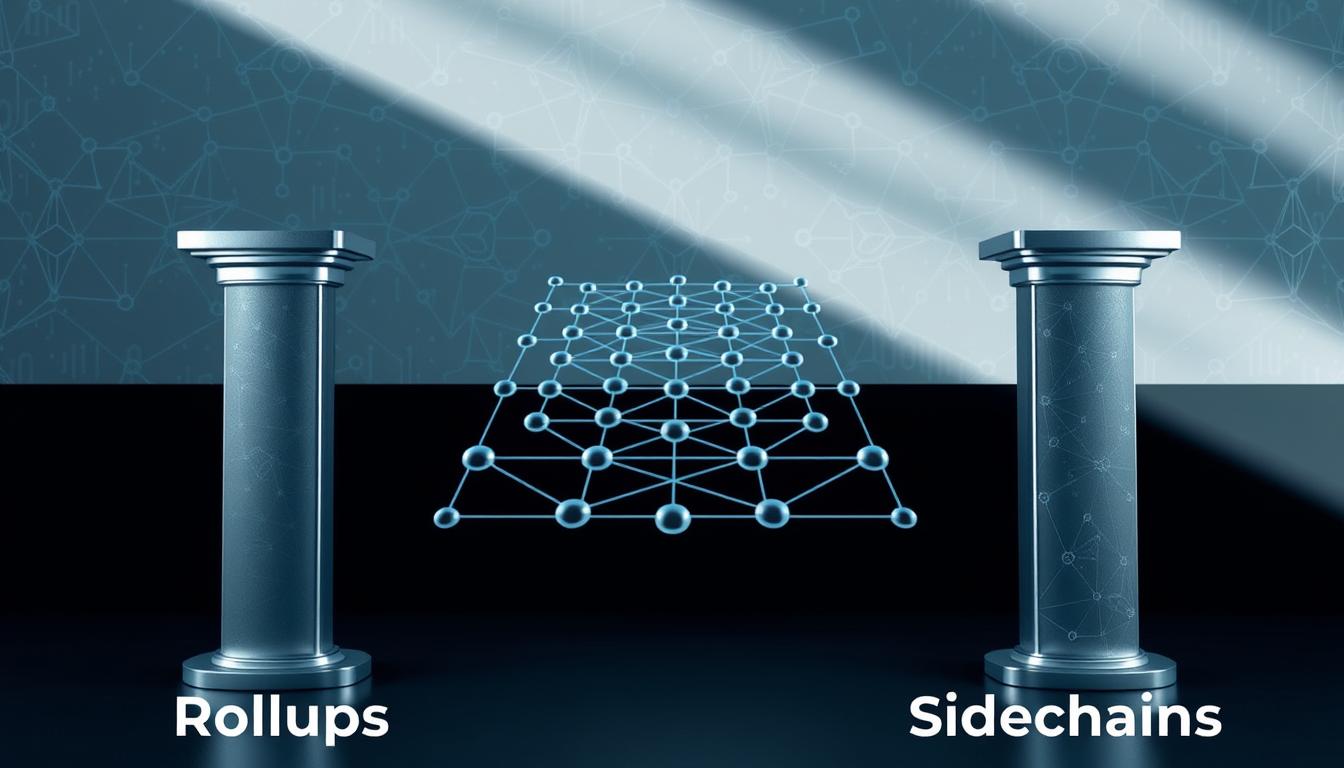Now Reading: Rollups vs Sidechains: A Comprehensive Guide
- 01
Rollups vs Sidechains: A Comprehensive Guide
Rollups vs Sidechains: A Comprehensive Guide

The rapid growth of Web3 has exposed a critical challenge: blockchain networks often struggle to handle high demand. Popular platforms like Ethereum face sky-high fees and slow processing times during peak usage. These limitations create barriers for developers building decentralized apps and users seeking fast, affordable transactions.

To solve these problems, two types of scaling solutions have gained traction. The first processes transactions outside the main network while keeping security tied to the original chain. The second operates as a separate ecosystem with its own rules for validating activity. Both approaches aim to reduce congestion but take fundamentally different paths.
Understanding these key differences matters for anyone working in Web3. Developers must choose tools that balance speed, cost, and security. Users need clarity on how their transactions are handled. This guide breaks down how each solution works, where they excel, and what tradeoffs they involve.
Key Takeaways
- Blockchain congestion drives demand for efficient scaling methods
- Layer 2 solutions reduce main network strain through off-chain processing
- Independent networks offer flexibility but require separate security measures
- Transaction speed and fees vary significantly between approaches
- Security models impact trust and decentralization levels
- Use cases differ based on developer needs and user priorities
Introduction to Blockchain Scaling Solutions
Picture a subway system designed for 100,000 daily riders suddenly facing 10 million commuters. This mirrors the strain on popular networks like Ethereum during peak activity. Transactions queue up like overcrowded train cars, with users paying premium fees just to squeeze into the next available block.

The Shift from Layer 1 Limitations
Base-layer blockchains face a tough choice: security, speed, or decentralization. Most prioritize safety, creating bottlenecks when apps gain traction. Ethereum’s average transaction fee spiked to $196 during 2021’s NFT boom – more expensive than international bank transfers.
Alternative networks like Solana emerged by changing the rules. Their secret? Specialized designs that process thousands of transactions per second. But switching ecosystems fragments liquidity and forces developers to rebuild tools from scratch.
Why Scalability Matters in Today’s Web3 Ecosystem
Modern decentralized apps need to support millions of users simultaneously. A game allowing NFT trades can’t freeze when 5,000 players make moves. Payment systems require instant confirmations – waiting minutes for blockchain finalization kills real-world usability.
Three critical factors drive demand for scalability solutions:
- User experience expectations set by web giants like Amazon
- Growing institutional interest in blockchain technology
- Expanding use cases beyond simple token transfers
Upgrading base-layer infrastructure often requires complex consensus changes. This technical reality makes layer 2 approaches crucial for maintaining network effects while improving performance.
Deep Dive into Layer 2 Rollups
Imagine a factory where workers bundle products into pallets instead of shipping items individually. That’s essentially how these scaling systems handle blockchain activity. By moving computation off the main network, they process hundreds of transactions as single packages while keeping security rooted in the original chain.

How Transactions Get Bundled and Verified
Here’s how it works: Operators collect actions from users and process them outside the congested base layer. Thousands of individual swaps or transfers get squeezed into one compressed block. This batched data then returns to the main network for permanent recording, slashing fees by up to 100x compared to solo transactions.
Optimistic Versus Zero-Knowledge Approaches
Two distinct methods dominate this space. Optimistic systems like Arbitrum assume all transactions are valid unless challenged. Users must wait days to withdraw funds while potential disputes get resolved. The upside? Full compatibility with existing Ethereum apps makes migration seamless.
Zero-knowledge alternatives use advanced cryptography to validate actions instantly. Complex mathematical proofs confirm accuracy without exposing sensitive details. While faster, generating these proofs demands specialized hardware – a trade-off between speed and resource requirements.
Exploring Independent Sidechains
Imagine building a new highway next to an existing road to ease traffic. Independent blockchains work similarly, running parallel to major networks while handling their own transactions. These systems maintain critical links to their primary chains through secure bridges, creating scalable alternatives without abandoning established ecosystems.
Operational Mechanics of Sidechains
Each sidechain operates like a self-contained network with unique rules. They use their own validators and consensus mechanisms to process transactions quickly. For example, Polygon PoS employs a Proof-of-Stake model separate from Ethereum’s system yet syncs checkpoint data back to its parent chain periodically.
Bridge protocols enable asset transfers between chains. Users lock tokens on the main network while minting equivalents on the sidechain. This two-way communication ensures consistency without slowing down either network.
Flexibility and Customization Benefits
Developers gain unprecedented control over blockchain parameters. They can adjust:
- Transaction fees to match application needs
- Block times for faster confirmations
- Governance models for decentralized control
This adaptability makes sidechains ideal for specialized use cases. Gaming platforms benefit from low-cost microtransactions, while enterprise solutions leverage custom privacy features. The parent chain serves as an anchor without dictating operational rules.
Rollups vs Sidechains: Detailed Comparison of Key Differences
Blockchain scaling solutions differ like bank vaults versus home safes – both store value but use radically different protection methods. The core distinction lies in how they handle transaction validation and risk management.

Chain-Linked Protection vs Custom Safeguards
One approach maintains an unbroken security chain to its parent network. Every transaction batch gets compressed and verified through the original blockchain’s established protocols. This method acts like armored trucks transporting valuables between secure facilities.
The alternative operates like a neighborhood watch program. Independent validators enforce custom rules optimized for speed and flexibility. While efficient, these systems depend on local participants rather than a global security network.
Three critical factors shape these security models:
- Connection strength to the primary blockchain
- Validator incentives and decentralization levels
- Fraud prevention mechanisms
Systems inheriting main chain security offer stronger guarantees against attacks. Their validation process leverages the parent network’s extensive miner/validator network. However, this comes with higher operational constraints and potential delays.
Custom security models enable faster transactions and specialized features. Newer networks often face growing pains as their validator ecosystems mature. Users must assess whether performance gains outweigh potential early-stage risks.
Security Considerations in Scaling Solutions
Protecting digital assets in scaling systems resembles safeguarding a vault with multiple layers of defense. While efficiency gains attract attention, security mechanisms ultimately determine a solution’s long-term viability.
Security Inheritance From the Parent Chain
Some scaling methods directly leverage the parent network’s protection. Transactions bundle through trusted nodes called sequencers before anchoring to the main chain. This setup inherits the base layer’s battle-tested security but introduces new risks:
- Single sequencers create temporary centralization points
- Potential transaction delays during network congestion
- Dependence on fraud-proof systems for dispute resolution
Validator Networks and Their Challenges
Independent networks use custom validator groups to confirm transactions. While faster, these systems face growing pains. Early-stage chains often launch with small validator sets to maintain efficiency, creating centralization risks until participation expands.
Key trade-offs include:
- Faster consensus vs reduced node diversity
- Custom rules enabling specialized privacy-enhancing blockchain technology
- Separate incentive structures requiring careful design
Both approaches demonstrate that security in scaling solutions isn’t absolute – it’s a spectrum balancing protection, speed, and decentralization.
Transaction Efficiency, Cost, and Decentralization Trade-Offs
Think of a busy airport adding express security lanes to reduce passenger wait times. Scaling solutions create similar efficiency gains by reimagining how blockchain networks process activity. The balance between speed, fees, and network control determines which approach works best for specific needs.
Impact on Transaction Throughput and Fees
Off-chain processing systems bundle hundreds of actions into single batches. This method slashes fees by splitting settlement costs across many users. Data shows these solutions reduce costs by 80-95% compared to base-layer networks.
Independent chains take optimization further. They eliminate reliance on parent networks entirely, allowing custom fee structures. Some process 10,000+ transactions per second – rivaling traditional payment processors.
Three factors shape these trade-offs:
- Batch size: Larger groups lower individual costs
- Network independence: Custom rules enable faster speeds
- Security alignment: Shared validation vs autonomous systems
While independent chains offer lower fees, they require users to trust new validator groups. Systems tied to established networks leverage existing security but face occasional congestion delays. Developers must choose between maximum speed and battle-tested protection.
Developer Insights and Use Case Scenarios
Developers building in Web3 face a critical choice: optimize for compatibility or customization. Scaling solutions each address specific needs, from maintaining Ethereum-like ecosystems to enabling experimental features.
EVM Compatibility and Smart Contract Limitations
Systems preserving EVM compatibility let developers reuse existing code with minimal changes. This approach powers platforms like Loopring, which handles decentralized trading at 1/10th of Ethereum’s costs. Migrating dApps becomes straightforward when transaction logic remains unchanged.
Independent networks often sacrifice this compatibility for specialized functions. Custom consensus models or privacy features require rebuilding smart contracts from scratch – a trade-off for teams needing unique capabilities.
Real-World Applications and Use Case Examples
High-frequency DeFi protocols thrive on systems mirroring Ethereum’s security. NFT marketplaces and lending platforms benefit from reduced fees while maintaining user trust through shared validation.
Gaming platforms and enterprise solutions often choose customizable environments. Polygon’s Proof-of-Stake chain demonstrates how sidechains enable microtransactions and custom governance. Experimental projects leverage this flexibility to test novel tokenomics or privacy tools.
Choosing between these approaches depends on priorities. Established apps gain immediate scaling through EVM-aligned systems. Innovators building niche solutions value the freedom to redefine network rules.
FAQ
How do rollups and sidechains differ in security models?
Rollups inherit security directly from the main chain (like Ethereum) by submitting compressed transaction data. Sidechains operate independently, relying on their own validator networks, which may introduce risks if decentralization is compromised.
Which scaling solution offers lower transaction costs?
Rollups typically reduce fees by processing transactions off-chain and submitting proofs to the main chain. Sidechains like Polygon can achieve even lower costs but trade off direct security guarantees from Ethereum.
Can rollups support custom consensus mechanisms?
No—rollups depend on the main chain’s consensus. Sidechains, however, enable full customization, allowing projects to experiment with novel protocols tailored to specific use cases like gaming or DeFi.
Are optimistic rollups slower than zk-rollups?
Yes. Optimistic rollups (e.g., Optimism) have 7-day dispute periods, delaying withdrawals. zk-Rollups (e.g., zkSync) use validity proofs for instant finality, though they require more computational resources.
Why do sidechains face higher centralization risks?
Many sidechains use smaller validator sets to boost speed, creating potential single points of failure. Networks like Polygon PoS rely on 100 validators, compared to Ethereum’s thousands of nodes.
Is EVM compatibility possible with both solutions?
Yes. Rollups like Arbitrum and sidechains like BNB Smart Chain support EVM, enabling seamless migration of Ethereum dApps. However, some zk-Rollups require code adjustments due to proof complexity.
Which use cases favor sidechains over rollups?
Sidechains excel in high-throughput applications (e.g., Axie Infinity’s Ronin) where low latency and custom features matter. Rollups are better for protocols needing Ethereum-level security, such as decentralized exchanges.
Do rollups require users to trust third parties?
Optimistic rollups assume honest actors to challenge invalid transactions during dispute windows. zk-Rollups eliminate trust by using cryptographic proofs, ensuring validity without relying on external parties.
How do validity proofs enhance Layer 2 security?
Validity proofs (used in zk-Rollups) cryptographically verify transaction batches without revealing sensitive data. This ensures fraud prevention while maintaining privacy, unlike optimistic models that depend on social consensus.













